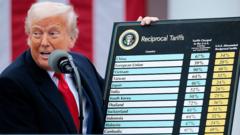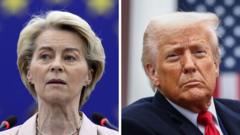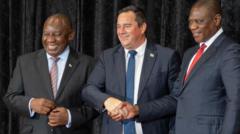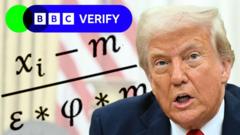In a bold move, President Trump has instituted a wide-ranging series of tariffs, aimed at revitalizing American manufacturing while sparking debate internationally about their potential economic ramifications. Here’s a closer look at the details of his aggressive tariff strategy.
Trump's New Tariffs: An Economic Gamble with Global Impact
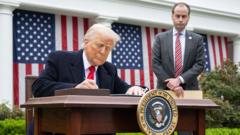
Trump's New Tariffs: An Economic Gamble with Global Impact
US President Donald Trump's recent tariffs are set to reshape international trade dynamics amid growing backlash.
The Trump administration unveiled a series of new tariffs effective April 5, starting with a baseline import tax of 10% on all foreign goods entering the United States. This base rate aims to address perceived trade imbalances and bolster American jobs. Key nations such as the United Kingdom and Brazil will be subject to this standard fee, although it is anticipated that these tariffs will eventually be passed on to consumers.
In addition to the flat rate, the administration has singled out about 60 countries as "worst offenders," imposing tailored tariffs that could reach as high as 54% on imports from China. European entities, too, will face heightened tariffs of around 20%. Countries like Vietnam and Thailand are not far behind, with rates fluctuating based on trade practices believed to undermine US economic interests.
Interestingly, neighboring countries Canada and Mexico have been excluded from the new tariffs as they are already addressed under previous measures related to trade agreements and border control issues.
Moreover, the newly announced plan includes a startling 25% tariff on all foreign-made automobiles. This price hike is indicative of Trump’s commitment to prioritize domestic manufacturing at a time when many industries are already grappling with global supply chain challenges.
As global leaders voice their dissent over the potential trade wars ignited by these measures, many economists are preparing for a turbulent economic landscape as the dust settles on Trump's latest trade strategy.
In addition to the flat rate, the administration has singled out about 60 countries as "worst offenders," imposing tailored tariffs that could reach as high as 54% on imports from China. European entities, too, will face heightened tariffs of around 20%. Countries like Vietnam and Thailand are not far behind, with rates fluctuating based on trade practices believed to undermine US economic interests.
Interestingly, neighboring countries Canada and Mexico have been excluded from the new tariffs as they are already addressed under previous measures related to trade agreements and border control issues.
Moreover, the newly announced plan includes a startling 25% tariff on all foreign-made automobiles. This price hike is indicative of Trump’s commitment to prioritize domestic manufacturing at a time when many industries are already grappling with global supply chain challenges.
As global leaders voice their dissent over the potential trade wars ignited by these measures, many economists are preparing for a turbulent economic landscape as the dust settles on Trump's latest trade strategy.



